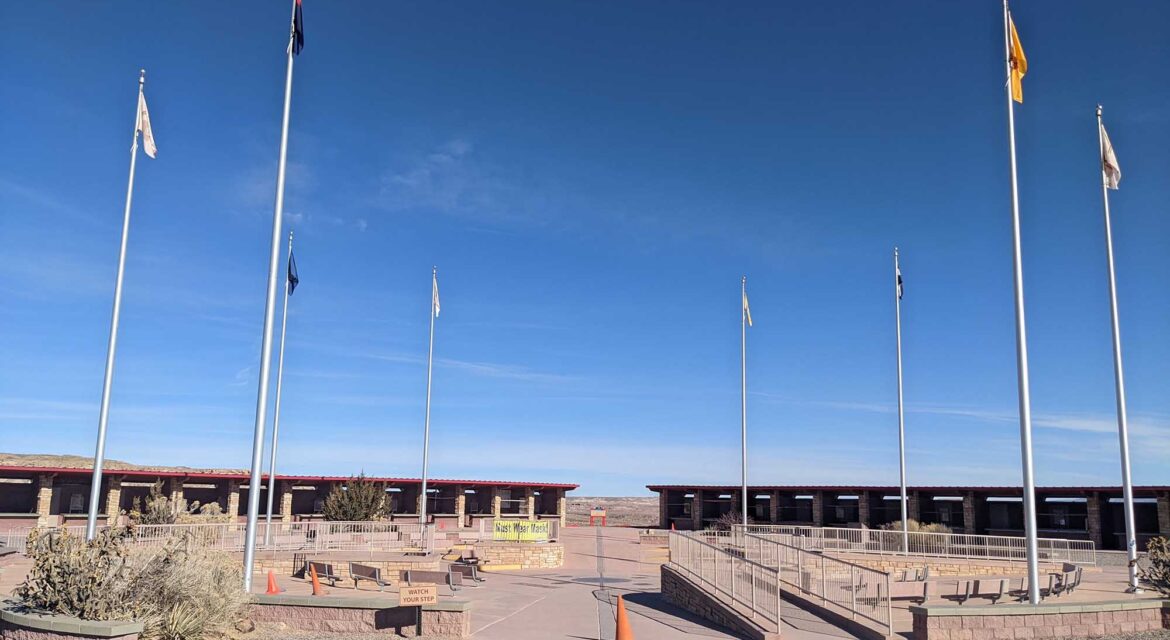 The Four Corners Monument marks the location where the states of Arizona, Colorado, New Mexico, and Utah meet. The only quadripoint in the United States, what is little more than a mapping anomaly has become a landmark for the region and country, highlighting how something random and formless can become a defined attraction.
The Four Corners Monument marks the location where the states of Arizona, Colorado, New Mexico, and Utah meet. The only quadripoint in the United States, what is little more than a mapping anomaly has become a landmark for the region and country, highlighting how something random and formless can become a defined attraction.
From Marker to Monument
 The Compromise of 1850 created the New Mexico Territory and Utah Territory, which would establish the first boundary line of the eventual Four Corners Monument. The Colorado Territory was created in 1861 while the Arizona Territory would form in 1863, creating the quadripoint of the modern Four Corners.
The Compromise of 1850 created the New Mexico Territory and Utah Territory, which would establish the first boundary line of the eventual Four Corners Monument. The Colorado Territory was created in 1861 while the Arizona Territory would form in 1863, creating the quadripoint of the modern Four Corners.
Efforts to survey and mark the actual borders of each state are recounted on a series of markers that reside in each section of the Four Corners Monument. The first survey of the boundary line was marked with a sandstone marker in 1868. Another was added in 1875. After these markers fell into disrepair, a single stone was set at the location in 1899. The first permanent marker was placed at the site in 1912. This began the site’s transition from being a simple marker to national monument.
A bronze disk was placed at the Four Corners meeting point in 1931. In 1962, the Bureau of Land Management and the Bureau of Indian Affairs poured an elevated concrete pad around the 1931 brass marker. The monument was refurbished in 1992 with a new bronze disk embedded in granite. This disk remained when the monument was again rebuilt in 2010.
The history and form of the Four Corner Monument have come to define the activities that audiences can experience all across the area, allowing them to connect with the culture and community of the region in a profound manner.

Culture, Activities and More
 As a direct means of revenue, visitors are charged to enter the grounds. Guided tours are available, while the monument also contains space for events and small gatherings. Race series and bike festivals are just a few examples of the types of events that take place at and around the Four Corners Monument. Audiences can interact with the space in a variety of ways, whether that’s by standing in different states at the same time or straddling all four.
As a direct means of revenue, visitors are charged to enter the grounds. Guided tours are available, while the monument also contains space for events and small gatherings. Race series and bike festivals are just a few examples of the types of events that take place at and around the Four Corners Monument. Audiences can interact with the space in a variety of ways, whether that’s by standing in different states at the same time or straddling all four.
A small Demonstration Center featuring traditional, handmade Native jewelry, artisan crafts, and tribal food resides on the ground. Craftsmen and artists from the Navajo and Ute tribes are represented at distinct stands on all four sides of the monument, each corresponding to a different state. Vendors sell handmade jewelry, crafts and traditional foods at various spots across the area. Each state promotes and takes pride in how its culture and history are represented as part of the monument.
With the markers and setup changing over the decades, these connections with the space, community and culture prove that the creation of a true monument is as much about an idea as it is a physical space or structure.

Creating a Legacy
 Defining the Four Corners region and residing in a rural area where there are no accommodations and services are limited, the Four Corner Monument highlights how a simple mapping quirk has become something much more. A monument was created out in the middle of nowhere thanks to an effort to celebrate nothing more than the territorial boundaries of a country, highlighting how simple it can be to turn the mundane into something monumentous.
Defining the Four Corners region and residing in a rural area where there are no accommodations and services are limited, the Four Corner Monument highlights how a simple mapping quirk has become something much more. A monument was created out in the middle of nowhere thanks to an effort to celebrate nothing more than the territorial boundaries of a country, highlighting how simple it can be to turn the mundane into something monumentous.


